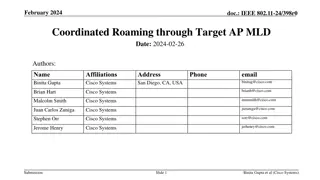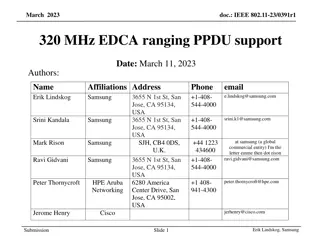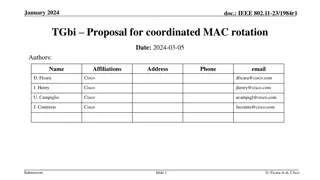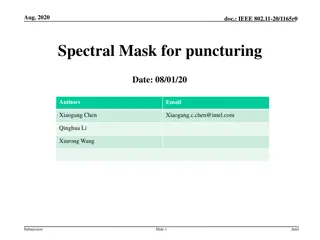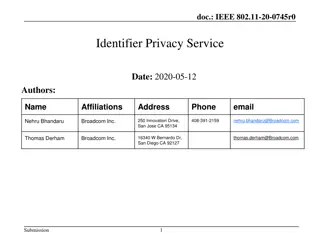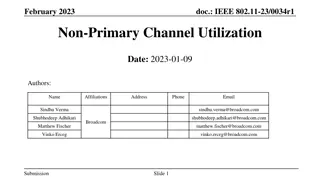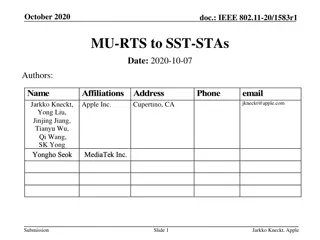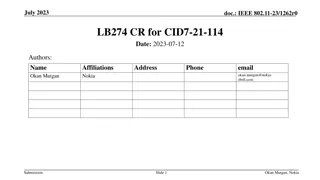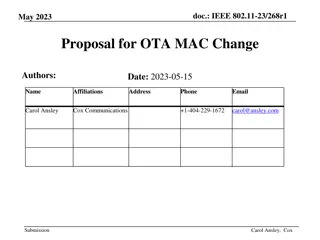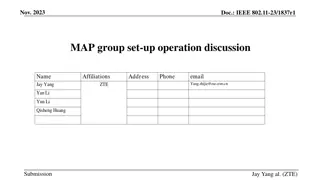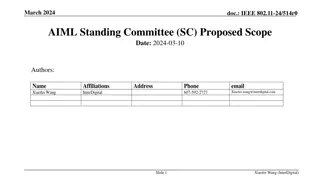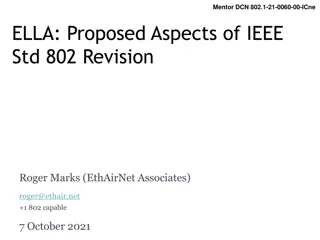Naming Conventions in IEEE 802.15 TG3d Proposal
This document discusses naming conventions in the context of IEEE 802.15 TG3d, focusing on the THz PHY, pairnet concept, and HRCP applications. It distinguishes between TG3d and TG3e, highlighting commonalities and differences in device operations, frequency bands, and application scenarios.
Download Presentation

Please find below an Image/Link to download the presentation.
The content on the website is provided AS IS for your information and personal use only. It may not be sold, licensed, or shared on other websites without obtaining consent from the author. Download presentation by click this link. If you encounter any issues during the download, it is possible that the publisher has removed the file from their server.
E N D
Presentation Transcript
September 2016 doc.: IEEE 802.15-16-0690-01-003d_Final_Proposal_3d_Explanations Project: IEEE P802.15 Working Group for Wireless Personal Area Networks (WPANs) Submission Title: Some thoughts on naming conventions in TG3d Date Submitted: 15 September 2016 Source: Thomas K rner (TU Braunschweig) Address Schleinitzstr. 22, D-38092 Braunschweig, Germany Voice:+495313912416, FAX: +495313915192, E-Mail: kuerner@ifn.ing.tu-bs.de Re: 15-16-0595-00-003d-proposal-for-ieee802-15-3d-thz-phy Abstract: This document discusses naming conventions wrt to the THz, parinet and HRCP nature of TG3d Purpose: To be considered in TG3d baseline document Notice: This document has been prepared to assist the IEEE P802.15. It is offered as a basis for discussion and is not binding on the contributing individual(s) or organization(s). The material in this document is subject to change in form and content after further study. The contributor(s) reserve(s) the right to add, amend or withdraw material contained herein. Release: The contributor acknowledges and accepts that this contribution becomes the property of IEEE and may be made publicly available by P802.15. Submission Slide 1 Thomas K rner (TU Braunschweig)
September 2016 doc.: IEEE 802.15-16-0690-01-003d_Final_Proposal_3d_Explanations Scope of TG3d Within TG3d a new PHY operating at 252 to 325 GHz is developed for switched point-to-point links The amendment developed inTG3d distinguishes from the baseline standard by introducing a PHY for new frequency range -> THz PHY the concept of point-to-point links, where only two devices are involved. This is the same concept as introduced by the parallel running project TG3e and is called there a pairnet Submission Slide 2 Thomas K rner (TU Braunschweig)
September 2016 doc.: IEEE 802.15-16-0690-01-003d_Final_Proposal_3d_Explanations Scope of TG3e Within TG3e a new PHY, but still operating at 60 GHz is developed for High-Rate Close proximity (HRCP) applications. HRCP also involves only two devices. Therefore the concept of pairnet is introduced. HRCP devices are always operating in a pairnet. Submission Slide 3 Thomas K rner (TU Braunschweig)
July 2016 doc.: IEEE 802.15-16-0690-01-003d_Final_Proposal_3d_Explanations Commonalities and Differences between TG3d and TG3e Commonalities: In both cases the devices are always operated as pairnet Differences: TG3d operatores at the 300 GHz band (THz) and TG3e operates at the 60 GHz band. Partly commonalities/partly differences: Some applications in TG3d are HRCP applications, soem are not (see next slide) Submission Slide 4 Thomas K rner (TU Braunschweig)
September 2016 doc.: IEEE 802.15-16-0690-01-003d_Final_Proposal_3d_Explanations HRCP and non-HRCP applications are considered in TG3d 10...100 Gbit/s 10...100 Gbit/s HRCP Intra-Device Communication Kiosk downloads 10...100 Gbit/s 10..100 Gbit/s Non-HRCP Wireless Links in Data Centers Backhaul/Fronthaul links Submission Slide 5
September 2016 doc.: IEEE 802.15-16-0690-01-003d_Final_Proposal_3d_Explanations Oberservations made in P802.15.3e D04 The terms pairnet and HRCP are sometimes used as synonym . It is not always clear, which elements are due to the HRCP nature and which features are due to the parinet nature. Example: The HRCP PNC is rather a pairnet coordinator Submission Slide 6 Thomas K rner (TU Braunschweig)
September 2016 doc.: IEEE 802.15-16-0690-01-003d_Final_Proposal_3d_Explanations Proposal for the naming conventions (1/2) Throughout both amendments a clear distinction has to be made: The term THz PHY should be used, whenever the feature is a special case that applies for the 300 GHz band and the corresponding THz PHY. The term HRCP PHY should be used, whenever the feature is a special case that applies for specific HRCP PHY (oeprating at 60 GHz). The term pairnet should be used, whenever it is a special case for pairnets in general and not restricted to HRCP only The term HRCP should be used, whenever it is a special case for HRCP applications only. Submission Slide 7
September 2016 doc.: IEEE 802.15-16-0690-01-003d_Final_Proposal_3d_Explanations Proposal for the naming conventions (2/2) The term THz pairnet should be used, whenever the feature is a special case that applies for a pairnet and the THz PHY only. The term THz HRCP should be used, whenever the feature is a special case that applies for the combination of an HRCP and the THz PHY only. The term THz non-HRCP pairnet should be used, whenever the feature is a special case that applies for the combination a THz pairnet and non-HRCP only. Submission Slide 8 Thomas K rner (TU Braunschweig)
September 2016 doc.: IEEE 802.15-16-0690-01-003d_Final_Proposal_3d_Explanations Overview of Features adressed and names (to be) used in TG3d and TG3e future 3?? HRCP PHY THz PHY 3d PHY Piconet Pairnet 3e Pairnet/ Piconet HRCP/ Non- HRCP HRCP Non- HRCP Submission Slide 9 Thomas K rner (TU Braunschweig)




















